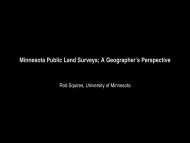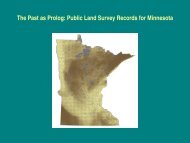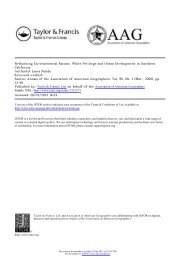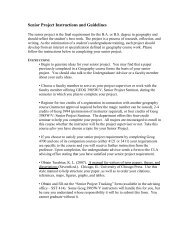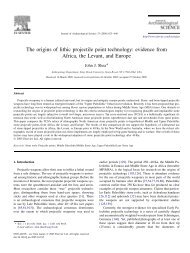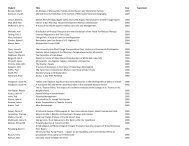Studies Question the Pairing of Food Deserts and Obesity
Studies Question the Pairing of Food Deserts and Obesity
Studies Question the Pairing of Food Deserts and Obesity
- No tags were found...
You also want an ePaper? Increase the reach of your titles
YUMPU automatically turns print PDFs into web optimized ePapers that Google loves.
2/26/13 <strong>Food</strong> <strong>Deserts</strong> <strong>and</strong> <strong>Obesity</strong> Role Challenged - NYTimes.comtake two or three buses, maybe pay for a taxicab, in order to do it.”Mrs. Obama has also advocated getting schools to serve healthier lunches <strong>and</strong> communities tobuild more playgrounds.Her <strong>of</strong>fice referred questions about <strong>the</strong> food deserts issue to <strong>the</strong> Department <strong>of</strong> Agriculture. Aspokesman <strong>the</strong>re, Justin DeJong, said by e-mail that fighting obesity requires “a comprehensiveresponse.” The federal effort, he added, includes not just improving access to healthy foods butalso improving food in schools, increasing physical education time, <strong>and</strong> educating people on <strong>the</strong>importance <strong>of</strong> healthy diets.Some researchers <strong>and</strong> advocates say that fur<strong>the</strong>r investigation is still needed on whe<strong>the</strong>rgrocery stores <strong>and</strong> chain supermarkets in poor neighborhoods are selling produce that is toocostly <strong>and</strong> <strong>of</strong> poor quality. “Not all grocery stores are equal,” said John Weidman, deputyexecutive director <strong>of</strong> <strong>the</strong> <strong>Food</strong> Trust, an advocacy group in Philadelphia.It was difficult to design a study that could rigorously answer <strong>the</strong> questions: Do poor urbanneighborhoods lack places to buy fresh produce <strong>and</strong> is that contributing to obesity? But HelenLee <strong>of</strong> <strong>the</strong> Public Policy Institute <strong>of</strong> California, a nonpr<strong>of</strong>it, nonpartisan research organization,found a way. For data on where children lived <strong>and</strong> went to school <strong>and</strong> how much <strong>the</strong>y weighed,she used a federal study <strong>of</strong> 8,000 children. For data on <strong>the</strong> location <strong>of</strong> food establishments, sheused a data set that compiled all <strong>the</strong> businesses in <strong>the</strong> nation <strong>and</strong> included <strong>the</strong>ir sizes <strong>and</strong>locations.“I knew where <strong>the</strong> children lived, so let’s take <strong>the</strong> middle <strong>of</strong> that neighborhood,” Dr. Lee said.“What is <strong>the</strong> nearest grocery store? What is <strong>the</strong> nearest convenience store?”She used census tracts to define neighborhoods because <strong>the</strong>y tend to have economicallyhomogeneous populations. Poor neighborhoods, Dr. Lee found, had nearly twice as many fastfood restaurants <strong>and</strong> convenience stores as wealthier ones, <strong>and</strong> <strong>the</strong>y had more than three timesas many corner stores per square mile. But <strong>the</strong>y also had nearly twice as many supermarkets<strong>and</strong> large-scale grocers per square mile. Her study, financed by <strong>the</strong> institute, was published in<strong>the</strong> March issue <strong>of</strong> Social Science <strong>and</strong> Medicine.Dr. Sturm’s study, published in February in The American Journal <strong>of</strong> Preventive Medicine, hada different design. With financing from <strong>the</strong> National Institutes <strong>of</strong> Health, he used data on <strong>the</strong>self-reported heights, weights, <strong>and</strong> diets <strong>of</strong> more than 13,000 California children <strong>and</strong> teenagersin <strong>the</strong> California Health Interview Survey. The survey included <strong>the</strong> students’ addresses <strong>and</strong> <strong>the</strong>addresses <strong>of</strong> <strong>the</strong>ir schools. He used a different data set to see what food outlets were nearby.Dr. Sturm found no relationship between what type <strong>of</strong> food students said <strong>the</strong>y ate, what <strong>the</strong>yMORE IN RESEARMediterranWard Off Hwww.nytimes.com/2012/04/18/health/research/pairing-<strong>of</strong>-food-deserts-<strong>and</strong>-obesity-challenged-in-studies.html?_r=2&pagewanted=print 2/4





